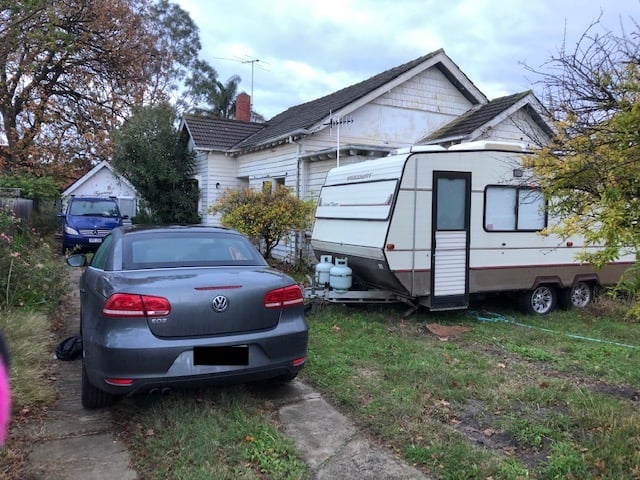
Thanks to our tribal ancestry, we see ourselves in terms of other people and groups. Evolution has taught us that it is beneficial to live in tribes, where we can share...
I have moved house four times in just over three years. You think that my family and I would be really good at moving, but there is always something that trips us up every time.
After having lived in the same house for 17 years, I had a dream that wouldn't let me rest. I wanted to renovate an old home and turn it into the house I wanted. My husband bought into my strategic vision and for over ten years we looked for a house that we could transform.
In January 2019, we finally found it - an old, weatherboard Californian bungalow that was about to be demolished. It didn't have many features - except for some diamond lead light windows, floorboards and a chimney. It had an outdoor toilet and a tiny, dirty kitchen that was barely functional. Even the electricity had even been removed. Fortunately, it had land, was located close to our children's school and it was in a suburb I never thought I could afford to live in again (thanks to Melbourne's booming property market).
So we bought it. The pressure was then on to fix up our current house and pack up our stuff. For weeks, I lay in bed at night modifying our action plan and the key steps to undergo a successful transformation.
There is something about living in a house for a long time - you accrue a lot of things. Given that both my husband are self-employed, we also have a lot of equipment for work. And dare I say, my husband is most probably a hoarder. We had quite a big garage, but the amount of stuff he stored in there was phenomenal (that even excluded all the equipment he stored at another location).
Planning the move took a lot of time and lots of tiny decisions. We planned on moving out the big things, the things we could see. Anything we didn't need for a couple of years we packed up and sent to our new shipping container that we stored in regional Victoria. I spent countless nights boxing things. By the time we had our first open for inspection, it looked like we lived this magical, idealised life of a tidy house and lots of floor space (see courtyard photo above).
It was a mirage.
When we finally moved (and had five months) to prepare, we thought it would be easy. After all, we had most of our things in storage and we had also sold or donated a lot of things. I booked a big truck for a day.
By 2pm on moving day, it became painfully obvious things weren't going well. There were still so many boxes to get into the truck. By the time we arrived at our new house, it was dusk. Under torch light, the movers literally shoved all the furniture into our small house (so we couldn't use any rooms).
Thankfully, we weren't living there on the first night. We went back to our old, clean house and slept on mattresses on the floor. We were exhausted and scared of what laid ahead.
The next day was even worse. It was settlement day. I started cleaning and packing up the bits and pieces strewn around the home at 6am. By 11.30am, we were getting frantic calls from our real estate agent about when we would hand in the keys. At 12pm, our real estate agent helped us out by booking another removals van.
We got out of there by 3pm with the purchaser's conveyancer threatening to not settle. It wasn't until we were driving to our new house (a solid 45 minute drive) that we got a call that the sale had gone through. It was a short-term win with little celebration because we knew that we were about to endure living in our caravan parked on the front lawn, in the middle of winter (it ended up being three weeks).

In the end, it wasn't the big pieces of furniture that made our move so traumatic. It was all the bits of stuff we had accrued that I didn't know existed, as well as all the little things I didn't know what to do with. Random cables, pieces of plastic from unknown items, toys, storage containers, pet toys and countless empty Yumi's hummus tubs and ginormous pickle jars. Items I should have thrown out, but was limited by lack of bin space and a fear of disappointing others. Not only that, leaving our comfortable house to something very uncomfortable was also highly triggering.
Our second move was 15 months later. During another Melbourne lockdown, our neighbours fled to New Zealand, pleading with us to move into their two-storey five bedroom house. "It will be great for you - you can start renovating," they said. And they were right - it was wonderful and the push we needed (we had become oddly comfortable with our small, lopsided house).
The move was easy. We just walked over what we needed, when we needed it (crossing the road and feeling illegal because we weren't allowed to visit neighbour's houses during lockdown). What was tricky was living with other people's stuff and not having a place for our own things. It was quite unsettling and weird.
We also didn't know when they would be back. The uncertainty meant I lost a lot of weight and barely slept (but hey, I got to write a book on sleepless nights). In the end, we lived in our neighbour's big house for seven months and had one month to find a place to live. We had started building an extension and our house was now more unliveable than when we bought it.
Our third move was to a small unit located close by. It was chosen under the mistaken belief we only needed it for less than six months. Again, it was a difficult move. Something about deadlines just don't work well for my family. Nor does moving from a big house to a tiny place. We still thought we didn't have much stuff to deal with, but we were suddenly left with a lot of furniture to store and lots of things we used regularly. The lack of house space meant I had to pack up things again and live minimally.
Fast forward to our fourth move (and the last for decades!), I mistakenly thought moving would be easy. Again, I was wrong. While it wasn't as traumatic as the first or third move (as we had progressively been moving items over for weeks), the last day was more work than I realised. Even with a cleaner helping me out, removalists and my husband, I underestimated the amount of little bits of crap hiding under furniture, stored in the carport and in my teenager's wardrobe (on the plus side, I did find a lot of dusty socks and hairbands that had been missing for months).
Yet, what I severely underestimated was that it just wasn't our physical stuff that took a long time to sort, it was also the emotional baggage that lay trapped underneath. From exposing a hidden conflict with my husband - his deep need to be surrounded by a lot of stuff and my need to have very little, as well as the more vocal emotions of our kids (who were still traumatised by leaving their childhood home).
The annual house moves took a toll on both our children (as well as lockdowns, changing schools and their respective neurodiversity challenges). They had change fatigue and refused to believe we were finally moving back home to a settled and easier life. The power of vision of a beautiful, clean and big house that was all ours had long lost its shine (or as my 18 year old proclaimed, "You have been promising this house to me since I was eight and now I'm planning when I can leave home.")
Yet, the whole experience has taught me a lot about when I can push people to change and when I cannot, as well as not ignoring the little things that become so overwhelming and energy-zapping.
Moving house is a bit like what we do when we announce a large-scale transformation to our employees.
For leaders, large-scale transformation can be exciting because they have wanted to hit some new organizational goals for a long period of time. Yet, what we forget is that other people have hidden emotions associated with change. They get the vision, but they're not quite ready for a change that is long and hard. Employee concerns and subsequent employee resistance can make us feel blind-sided when we feel strongly about a common goal. Sometimes, we even let employees know it will be difficult - that there will be issues and it will probably take longer than we expect. For some employees, it is never good enough. Like demanding, coddled teenagers, they expect everything to work out easily and smoothly (with very little effort on their part). Their need for high psychological safety is key.
Telling employees too early of a new change is probably not as motivational as we think. If some of your people are also neurodiverse (or suffer from Pathological Demand Avoidance, like my children, change might be doubly frightening).
We all get into a comfortable groove where our daily routines become settled and feel safe. Employees (children and pets) know what to expect from us and their day. We fall into a comfort zone (or what I label the Abatement Zone, the zone where we are declining in performance, but don't realise it).
It takes consistent communication and effective communication skills that are customised for different employee preferences to get the right messages across.
Leading with the vision is important and so is working out all of the big goals that need to happen. This takes time and planning. It also needs other people's contribution to find out all of the other little things that need to be dealt with. We have to involve employees in decision-making early on and collecting and acting on employee feedback. This takes patience and the willingness to provide the space for people to share all of the small, unseen things that are hiding in their heads that stop them from committing their full selves to the the change.
What makes these little things so hard is that we lump them all together. We lump all the tasks and human emotions into one until it becomes one big tangled mess.
During a move, you know not to throw every family member's clothes into one big box. You sort them into individual boxes. It makes it so much easier to unpack when you get to your destination.
Yet, that's what we tend to do with all the behaviours and interactions that our team members need to feel safe in the team. We lump everything together and think it will work for every individual. We expect everyone to react the same as us to a big change.
Leaders need to unpack and understand what their people need because it's the little bits of crap that slow us down. The tricky little human behaviours that sabotage our efforts to change and the little things that people are too scared to talk about.
It's not the big things, it's the small things that matter.
It's also getting help when we need it. Sometimes that might mean talking to HR about people strategies, employee development or working with the change department for tips on influencing others. Sometimes it might mean getting a coach, seeing a psychologist or practicing self-care. It also means asking our employees to help us know all the little things that need to be considered or even discarded. It's not easy because in the chaos of planning a project launch or product rollout, we forget (or we don't know what to do).
In my case, on took on too much. Effective change leaders, while they are important role models, they must make sure that they delegate tasks, so they don't burnout.
Change isn't something that comes naturally to humans.
A quote I heard recently from Prageet Harris is that "The old needs to drop away before the new can arise within you." Yet, we stubbornly hold onto the past and fear the new.
Moving house is a process of allowing the old to fall away. It can be traumatic because we become so emotionally attached with where we are. Yet, sometimes there is something bigger and better waiting for us that we need to experience, in order to be the person we want to be.
Everyone evolves at their own pace. Planning a big move or organizational transformation is really about giving our brains the time it needs to absorb that a new life is ahead of us. Some of us hold on tightly to where we are because it feels comforting and safe, while others jump onboard the change train gleefully and excited.
It's not until we have moved that we can finally let go of our old daily habits and behaviours. Sometimes the move is positive as we experience new things that light us up and give our lives meaning and joy. Other times, the move is negative and we find ourselves trapped in a small place that feels like our freedom and autonomy has been reduced.
What I learnt is to keep the dialogue open between family members. Focusing on the dream house didn't work with one teenager. Giving them the time and space to vent and complain seemed to be what they needed, as well as not reacting negatively to things they said that were hurtful.
In years to come, I know I will look back at this time as when myself and my family transcended our limitations and stepped into a new reality. A time when we all learnt individually who we really are and how to interact better with one another during uncertainty and pressure.
Of course, learning to combat change fatigue has now become part of life. And who knows, maybe my kids have developed nascent critical skills that will enable them to be future change leaders who shepherd large-scale changes with ease.
I realise that the little bits of crap that slowed everything down will be forgotten. Hopefully, some of the traumatic moments, will be replaced with a feeling of accomplishment and a sense of peace.
My hope is that we will remember and appreciate the good feelings. The joy of moving into a light-filled, airy bedroom. The delight of seeing our cats running around and curiously exploring their new space. The freedom of having our own place, designed in the way that suits us aesthetically and functionally. A place designed for all our things (but not needing to have lots of things!). And of creating a legacy that will last generations - a home where we feel we belong, that we are safe and that we have an exciting future ahead.

Thanks to our tribal ancestry, we see ourselves in terms of other people and groups. Evolution has taught us that it is beneficial to live in tribes, where we can share...

Measuring and improving employee engagement is often revered as the holy grail to improving business performance. Moderate employee engagement results encourage the...